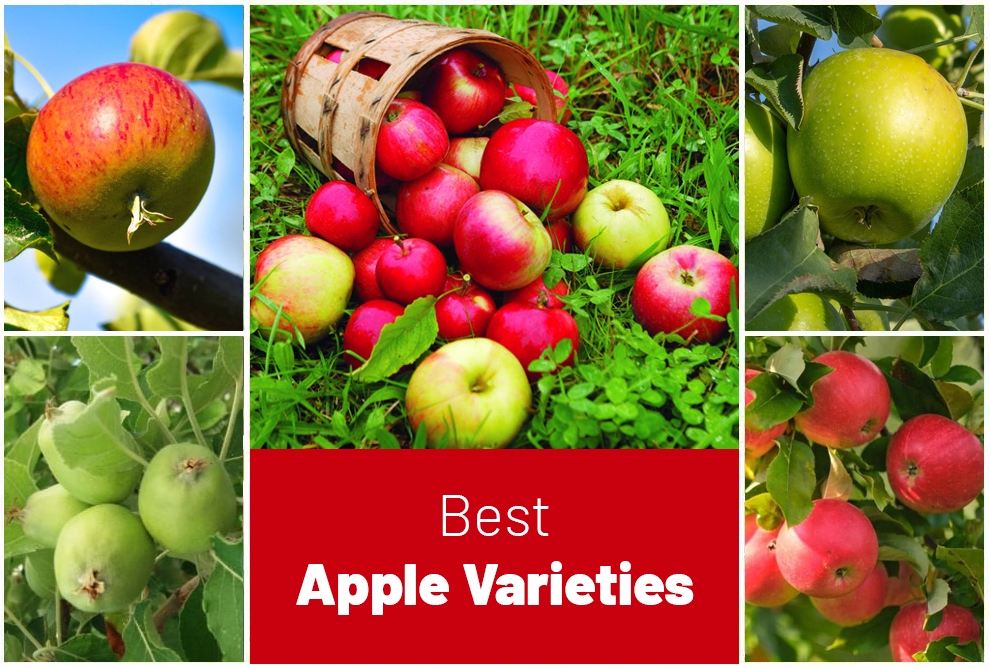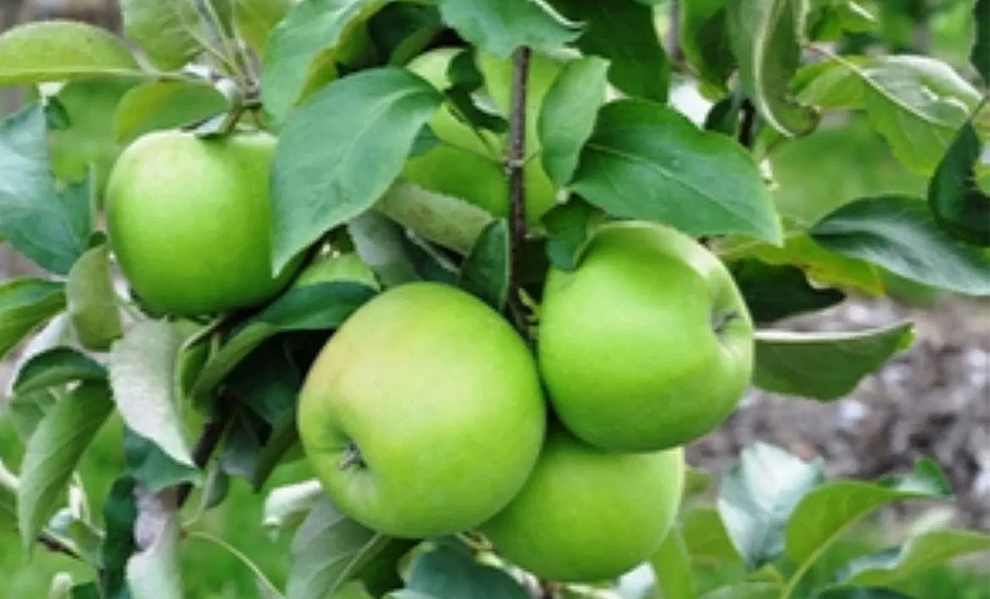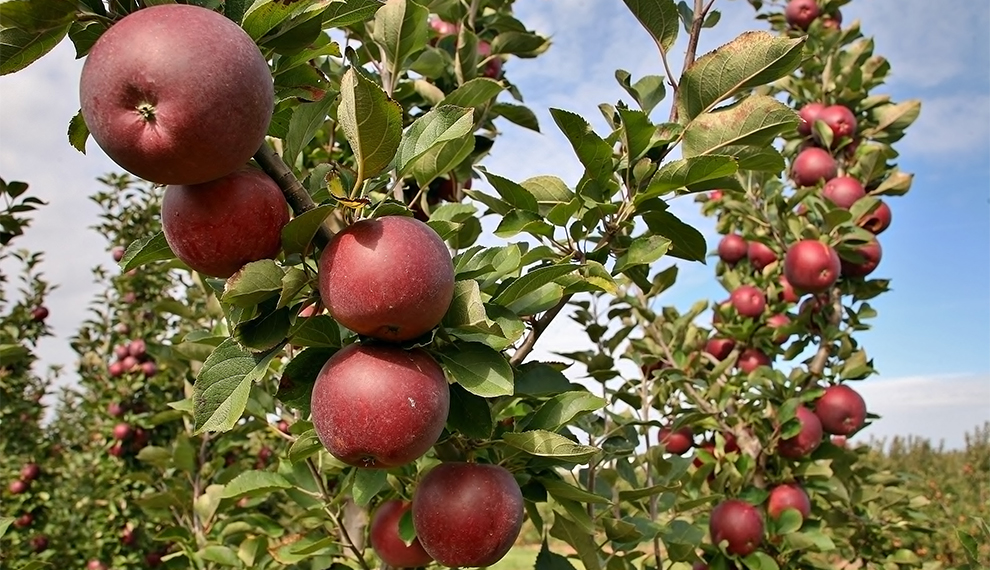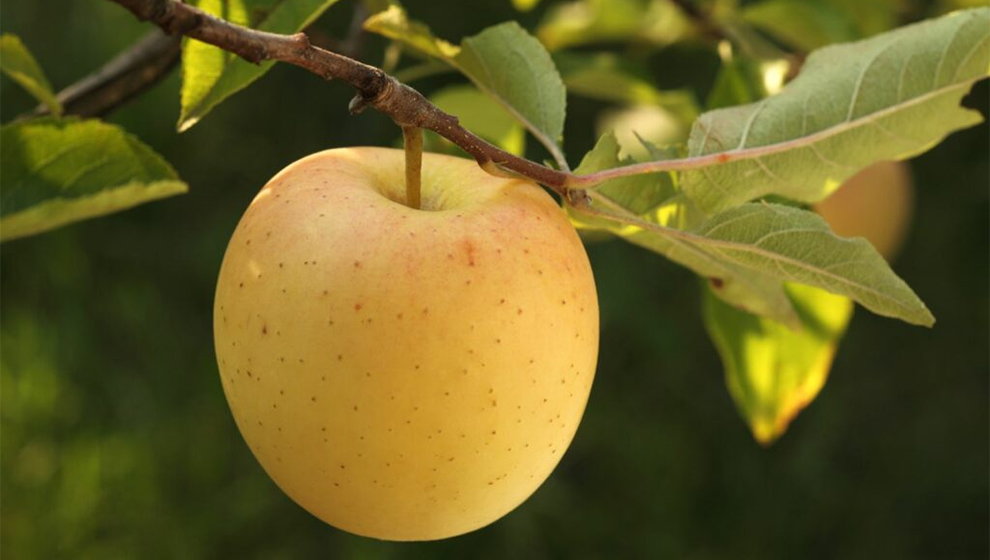Best Apple Varieties, Tree Types, and Popular Species
There are numerous apple tree varieties and actually next to impossible to name all of them. Honeycrisp, Granny Smith, Ginger Gold, Red Delicious, and McIntosh are some of the best tasting ones.

Tart or sweet? Green or red? Firm and crisp or yielding and soft? If you wish to plant an apple tree, choosing from the different types of apple trees is not easy.
With more than 30,000 varieties grown globally and over 2500 popular species in America alone, it is easy to assess why it is a difficult decision.
To help narrow your selection, we will discuss some of the most popular apple varieties you can grow in your yard.
Most apple trees are bred for utilitarian use and taste, including cider production and cooking. Fuji Apple and Honeycrisp Apple trees are two of the most popular species.
Apples are one of the most popular fruits in the world, with growers producing over 240 million bushels of apples in America every year. They are employed across the country for culinary standby like apple sauce and apple pie, not to mention juices, smoothies, snacking, and more.
While you can shop for them at any grocery store near you, you can also grow your apples in your backyard. And while you do that, you will get a massive reward for your effort – homegrown, fresh apples year after year.
Fortunately, you can choose from the different types of apple trees, depending on what works best for your garden and environmental conditions.
Apple Tree Information
| Species | Malus domestica |
| Hardiness zone | Three through Eight |
| Soil type needed | Well-drained, light to medium-textured soils with neutral pH |
| Sun | Full sun |
| Tree size | Four to thirty feet |
| Water | After planting, water them deeply. Once the tree starts spreading its root, water more. A year after the planting, change the watering schedule and water only once in 10 days. |
| Fruiting months | September to October |
| Lifespan | 50 to 80 years |
Best Apple Tree Species and Varieties
Here is a list of some of the best apple species you can consider planting in your garden:
Honeycrisp

| Growing Zone | Three through Eight |
| Tree Size | Eight to Ten feet |
| Fruiting Month | September |
Founded by the Horticultural Research Program researchers from the University of Minnesota, Honeycrisp is one of the favorite apples amongst Americans.
These cold hardy plants can survive in temperatures as low as -30 degrees, and their fruit does not immediately drop after ripening, which elongates the harvest.
Moreover, the plant has a sweet fruit with thin skin and larger cells than the other varieties. Hence, they are juicy with a crunchy, crisp exterior, explaining their prevalence in a pie or as a snack.
These offer a fine balance between tart and sweet, adding a lot of deliciousness to your backyard. As they are mid-sized plants, they are wonderfully manageable.
Honeycrisp apples need full sun to grow. They are self-pollinating and have yellow skin with reddish-pink blush speckles. Fortunately, the Honeycrisp is disease-resistant. Thus, they do not need too many sprays or chemicals. Once established, they are heavy producers.
Red Delicious

| Growing Zone | Five through Eight |
| Tree Size | 20-25 (standard), 10 feet (dwarf), and 12-15 feet (semi-dwarf) |
| Fruiting Month | Late September to mid-October |
These are popular apple tree varieties known to have a long shelf life. You can find them easily in grocery stores around the country because they remain juicy and crisp for three to six months, provided you store them properly.
These are mildly sweet varieties and are excellent for baking and eating. It is a biennial bearer, meaning the tree will bear fruit heavily one year but not the next. So, to avoid low-yield years, you must plant them a year apart to have one tree in maximum yield mode.
Anna

| Growing Zone | Six through Nine |
| Tree Size | 15 to 20 feet |
| Fruiting Month | June and early July |
A delectable, southern favorite, Anna apples are excellent producers you can grow at home. Developed in Israel for the first time at the Ein Shemer kibbutz, these apple trees were designed for a low-chill environment, as they live best in zones where the temperature does not frequently drop below freezing.
You can easily spot these types of apple trees in orchards across the Gulf states, Florida, Texas, and California. Though descended from the Golden Delicious apple, Annas taste and look like the Honeycrisp or Granny Smith.
Sweet and slightly acidic, these apples are versatile and fantastic to eat for baked goods and sauces. They can fruit in the first year and yield an excellent harvest in June and Early July. It produces light green-yellow apples that have a faint red blush.
Its flesh is crisp, slightly tart, and sweet. While some nurseries brand these trees as self-fertile, if you need a good crop, you must plant them within 50 feet of a Dorsett Golden to ensure pollination.
Red Jonathan
| Growing Zone | Four through Eight |
| Tree Size | 12 to 15 feet |
| Fruiting Month | September to October |
Red Jonathan has a uniquely sharp taste. It is ideal for long-term storage as the mid-sized apples are ideal for snacking. The plant looks extraordinarily beautiful while it is in full bloom.
It is a parent of several other cultivars and is one of the most sought-after heritage plants. Since these are small-sized trees, they look nice in cramped spaces where you cannot accommodate bigger specimens. The bright red fruit, juice, and sweetness with a zing make them ideal for desserts.
Granny smith

| Growing Zone | Six through Nine |
| Tree Size | 18 to 20 feet |
| Fruiting Month | October |
A classic tart apple, these are popular apple varieties from Australia. Since they have a short chill season, they are recommended for warmer climates. Known for their mouth-puckering tartness, Granny Smith is predominantly baked into pies or eaten as a snack.
They have greenish-white flesh and are crisp and juicy. Fortunately, they hold up well even when cooked. These apples have a high acid content. Thus, they prevent the flesh from browning quickly after you cut the fruit.
Once picked, you can store Granny Smith in cold storage for six months. They are resistant to diseases like fire blight and cedar apple rust.
Lodi

| Growing Zone | Three through Eight |
| Tree Size | Up to Twenty-five feet |
| Fruiting Month | Late June or early July |
These apple trees bloom early at the beginning of the spring and yield white flowers that show in clusters draped across the long tree branches. Its blooms are attractive to bees and butterflies and heavily fragrant.
Flowers are soon followed by a large apple production at the end of summer. Lodi yields mid-sized apples. They have yellowish-green skin, and the flesh is pale. Their apples have a soft bite and a sweet, mild flavor.
Lodi plants grow in full sun. They have a greater tolerance for different soil types but demand average moisture, deep, fertile, and well-draining soil. You can enjoy these apples in pies or as apple sauce.
The trees require pollination by another apple tree with a similar blooming period, like Braeburn. These varieties yield attractive apple trees in season earlier than most others.
Gala

| Growing Zone | Four through Ten |
| Tree Size | 18 to 25 feet (standard), 12 to 18 feet (semi-dwrf), and 10 feet (dwarf) |
| Fruiting Month | August through September |
Imported from New Zealand, Gala is one of the best apple varieties, as these Southern gems can keep you in apples for most of the year. You can harvest its fruit in the fall but enjoy the crisp Gala apples, unlike its cousins, for a longer duration.
It stores well sans losing its texture. They find excellent use in dried apple snacks as applesauce or in baked goods. You can identify a Gala from its red streaks on the golden-yellow skin and the heart shape.
It has a tangy-sweet flavor with hints of vanilla and white-flesh skin. Gala needs full sun to thrive. They have a beautiful floral fragrance.
Fuji

| Growing Zone | Six through Nine |
| Tree Size | 12 to 15 (semi-dwarf) and 8 to 10 (dwarf) |
| Fruiting Month | September through October |
As is apparent, Fuji is native to Japan and is made in part from the delicious red apples. They are a late-season, low-chill variety with a sweet flavor and resemble the delicious red apple.
Opt for these types of apple trees if you want to consume hearty apple juice. Fuji has a very sweet taste. It also means their sugar content is relatively higher than the other apple varieties.
You can have it as is, but you can pair it with a tart variety to obtain an apple sauce or pie, or else its sweetness will be overpowering.
Fuji thrives in full sun, but when it comes to watering, they can be a little fussy as they cannot endure drought conditions. So, please install an irrigation system or tree bag if you have younger trees. Fortunately, they are resistant to powdery mildew.
Arkansas Black

| Growing Zone | Four through Nine |
| Tree Size | 12 to 15 feet |
| Fruiting Month | November |
Arkansas Black can be an easy choice if you seek a unique but one of the best apple varieties to grow in your home garden. These fruits have very dark red skin that looks almost black.
The plant yields a sweet, crispy, and juicy fruit with a hint of cinnamon. Often referred to as the Cabernet of Apples, Arkansas Black is not the variety you eat fresh off the tree. These need a few months to cure.
However, once they are ready for consumption, Arkansas Black is delicious. You can eat them raw or in baked goods. It is also one of the commonly employed varieties of cider. It is a hardy and vigorous growing plant that is perfect for cooking.
Empire

| Growing Zone | Four through Nine |
| Tree Size | 15 feet |
| Fruiting Month | September |
Empire is a combination of two of the world’s most popular varieties that depicts the best traits of both McIntosh and Red Delicious. These are easy-to-grow trees. They yield fruits with an exceptionally sweet taste and a crisp snap with firm flesh.
They demand full sun to grow and are partially self-pollinating. Empire has rich red skin and white flesh. You can use it for baking, fruit salads, and fresh eating. These are small-sized apple trees ideal for compact spaces or smaller yards.
Pink Lady

| Growing Zone | Five through Nine |
| Tree Size | 15 to 20 feet |
| Fruiting Month | October to December |
Pink Lady apple tree species look delicious and are beautiful with their fuchsia flush on their striking yellow skin. They need a pollinator and thrive in full sun. Its medium-large fruits are highly aromatic and firm. The yellow-tinted white flesh is juicy and crispy, carrying notes of citrus and melon.
Every bite of this fruit has a slight zing from the subtle tartness, making it a great pick for snacking. You can enjoy it as juice, eat it raw, or as a baked good. This variety is rich in sugar and also has a high acidic content. These varieties are tart and sweet simultaneously.
Rome

| Growing Zone | Four through Nine |
| Tree Size | Dwarf – 8 to 10 feet, Semi dwarfs – 12 to 15 feet, and Standard size – 20 feet |
| Fruiting Month | October |
Rome apples are heirloom apples that have a tangy taste and work well as baking apples. It has a juicy, mild flavor and a bright red skin, and its flavor is accentuated by baking or sauteing.
They have a tangy taste, which makes for exceptional baking varieties. They are susceptible to prevalent apple diseases.
So, home growers usually end up frustrated by these trees because of their poor fruit production and short lives.
McIntosh

| Growing Zone | Four through Seven |
| Tree Size | Up to twenty feet |
| Fruiting Month | Late August to Mid-September |
These are the best apple varieties, christened after John McIntosh, a Canadian farmer who discovered the tree in Ontario in the early 1800s. It is a deciduous tree hugely popular in the US and Canada for its beauty as an ornamental tree and its ability to yield delicious fruits.
The plant has average moisture needs and requires full sun to grow. They thrive in fertile, deep, well-draining soil. Mcintosh blooms in early to mid-spring and yields white, fragrant flowers, followed by apples that arrive early in the season before fall.
Their apples have double-toned skin that is yellow-green and red. Their pale flesh is tangy and tender. You can use them for snacking or in dessert pies and apple sauce. The tree is resistant to diseases and is hardy in colder regions.
Golden Delicious

| Growing Zone | Four through Nine |
| Tree Size | 12-15 feet (semi-dwarf) and 8-10 feet (dwarf) |
| Fruiting Month | Late September |
These may look like a different colored variety from the Red Delicious apples. However, National Parks Service reports suggest that they are indeed not connected to the Red Delicious apples in anything except their name and the fact that they are both apple varieties.
As is apparent, these apples have a golden yellow peel once ripe and are sweet apples but not very crisp. Discovered on the family farm in West Virginia, Golden Delicious is the best pick for making cider. These have a custardy and rich taste.
Braeburn

| Growing Zone | Four through Ten |
| Tree Size | 12-15 feet (semi-dwarf) and 8-10 feet (dwarf) |
| Fruiting Month | Mid-October |
Braeburn is one of the most popular apple trees, especially for home gardeners. Even commercial growers will enjoy growing this apple variety. Originating in New Zealand, it accounts for forty percent of the apple production in the country and is in the top five for America.
It is easy to see why it is so hugely popular. The fruit has a crisp and perfect apple flavor. It is not very sugary, and many growers believe that Braeburns make Red Delicious, and the traditional Golden varieties seem one-dimensional.
These are cold-hardy, low-maintenance species that can grow in warmer climates too. You will notice a change in the flavor depending on where they grow. People use it for desserts and baking.
Related: How To Make Apple Trees Grow Faster | How To Take Care Of Apple Trees | How Long Do Apple Trees Live | Best Fertilizer For Apple Trees| When to Fertilize Apple Trees
Other Types Of Apple Trees
Some of the other apple varieties worth mentioning include:
- Washington
- Pinata
- Cox’s Orange Pippin
- Winesap
- Northern Spy
- Wealthy
- Jonagold
- Jonafree
- Ein Shemer
- Dorsett Golden
- Cortland
- Gravenstein
- Macoun
- Stayman Winesap
- Sweet Sixteen
You might also like: Ornamental Crabapple Tree Varieties | White Flowering Crabapple Trees| When To Plant Fruit Trees
Apple Tree Questions and Doubts
Ques 1. Which are the Dwarf small apple tree varieties?
Ans. Some dwarf small apple trees include Arkansas Black Dwarf, Goldrush Dwarf, Fuji Dwarf, Gala Dwarf, and Granny Smith Dwarf.
Ques 2. What is the easiest apple tree to grow?
Ans. Golden Delicious is one of the easiest apple trees to grow.
Ques 3. What are the best-tasting eating apples to eat raw?
Ans. Some of the best-tasting apples include:
- McIntosh
- Honey Crisp
- Cameo
- Liberty
- Ginger Gold
Ques 4. How can I tell what kind of apple tree I have?
Ans. In most cases, the only way to identify the apple tree variety is to have some documentation from the gardener who planted the tree, such as a journal entry, letter, receipt, or label.
Ques 5. Which are the best apples to eat for health?
Ans. Red Delicious and Granny Smith are the best apples for your health.
Ques 6. Which are the popular ornamental apple tree varieties?
Ans. Some ornamental apple trees include Red Sentinel, Crimson Cascade, Rudolph, and Evereste.
